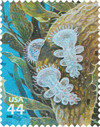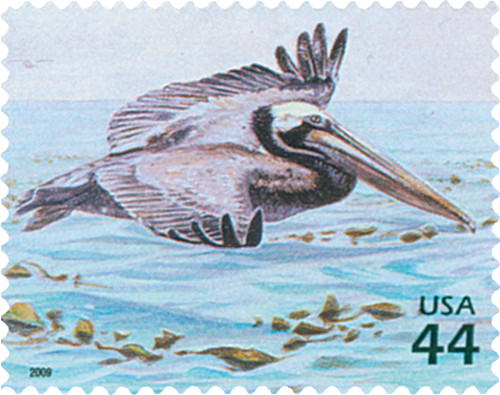
# 4423d - 2009 44c Kelp Forest: Lion's mane Nudibranch
Kelp Forest – Lion Mane Nudibranch
Nature of America
Issue Date: October 1, 2009
City: Monterey, CA
Although it looks like a gelatinous blob, the lion mane nudibranch is actually a predatory sea slug. Hunting for its food, the nudibranch attaches itself to kelp and extends its hood like a fisherman’s net. When a small marine animal comes into contact, the hood snaps shut. Held by overlapping tentacles, the animal is then swallowed whole.
The lion mane nudibranch preys primarily on copepods and amphipods, which are parasites that attach to fish, sharks, marine mammals, and many invertebrates. Feeding on these parasites, the nudibranch helps to preserve the health of the other kelp forest inhabitants.
An awkward swimmer, the sea slug propels itself by bending at the middle and thrashing its body from side to side. This disadvantage has led the nudibranch to evolve an interesting defense from predators. At the first sign of trouble, the nudibranch detaches knobs, called cerata, from its body. Ideally, this will lead the attacker to chase after the floating cerata or distract it long enough for a clumsy escape.
The lion mane nudibranch mutually fertilize each other and then attach their eggs to kelp. Reproducing at the age of one year, the nudibranch slug then dies.
Kelp Forest – Lion Mane Nudibranch
Nature of America
Issue Date: October 1, 2009
City: Monterey, CA
Although it looks like a gelatinous blob, the lion mane nudibranch is actually a predatory sea slug. Hunting for its food, the nudibranch attaches itself to kelp and extends its hood like a fisherman’s net. When a small marine animal comes into contact, the hood snaps shut. Held by overlapping tentacles, the animal is then swallowed whole.
The lion mane nudibranch preys primarily on copepods and amphipods, which are parasites that attach to fish, sharks, marine mammals, and many invertebrates. Feeding on these parasites, the nudibranch helps to preserve the health of the other kelp forest inhabitants.
An awkward swimmer, the sea slug propels itself by bending at the middle and thrashing its body from side to side. This disadvantage has led the nudibranch to evolve an interesting defense from predators. At the first sign of trouble, the nudibranch detaches knobs, called cerata, from its body. Ideally, this will lead the attacker to chase after the floating cerata or distract it long enough for a clumsy escape.
The lion mane nudibranch mutually fertilize each other and then attach their eggs to kelp. Reproducing at the age of one year, the nudibranch slug then dies.







